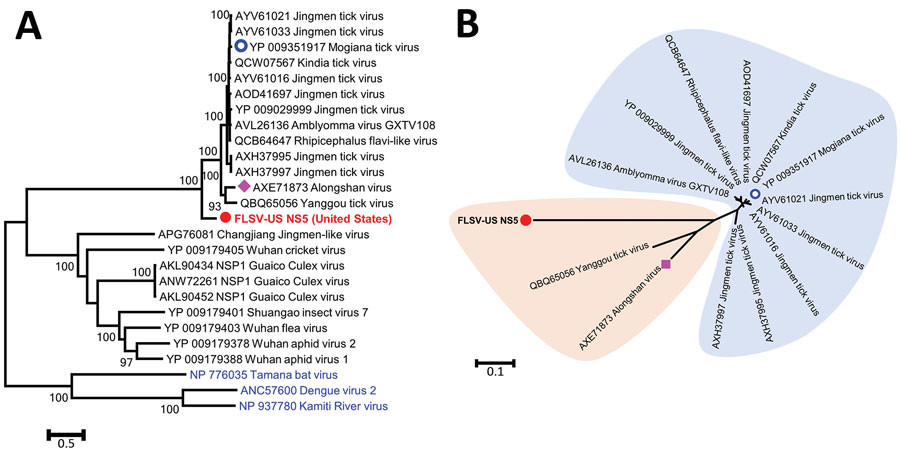Presence of Segmented Flavivirus Infections in North America
Kurt J. Vandegrift
1, Arvind Kumar
1, Himanshu Sharma, Satyapramod Murthy, Laura D. Kramer, Richard Ostfeld, Peter J. Hudson, and Amit Kapoor

Author affiliations: Center for Infectious Disease Dynamics, Pennsylvania State University, University Park, Pennsylvania, USA (K.J. Vandegrift, P.J. Hudson); Center for Vaccines and Immunity, The Research Institute at Nationwide Children’s Hospital, Columbus, Ohio, USA (A. Kumar, H. Sharma, S. Murthy, A. Kapoor); Wadsworth Center, New York State Department of Health, Albany, New York, USA (L.D. Kramer); University of Albany-SUNY School of Public Health, Albany (L.D. Kramer); Cary Institute of Ecosystem Studies, Millbrook, New York, USA (R. Ostfeld); Ohio State University College of Medicine and Public Health, Columbus (A. Kapoor)
Main Article
Figure 2

Figure 2. Phylogenetic analyses of FLSV-US (red) on the basis of NS5 proteins corresponding to amino acid positions 55 to 913 on Jingmen tick virus reference sequence YP_009029999.1. The trees are drawn to scale, with branch lengths measured in the number of substitutions per site. A) Phylogenetic analysis of conventional flaviviruses (blue) and recently identified segmented flavi-like viruses from ticks, mosquitoes, and other arthropods. B) Phylogenetic analysis of viruses closely related to FLSV-US. Alongshan virus was found in patients from China (purple diamond), Mogiana tick virus was found in ticks from Brazil (blue shading), and all other viruses were found in ticks collected in China. FLSV, flavi-like segmented virus.
Main Article
Page created: May 14, 2020
Page updated: July 21, 2020
Page reviewed: July 21, 2020
The conclusions, findings, and opinions expressed by authors contributing to this journal do not necessarily reflect the official position of the U.S. Department of Health and Human Services, the Public Health Service, the Centers for Disease Control and Prevention, or the authors' affiliated institutions. Use of trade names is for identification only and does not imply endorsement by any of the groups named above.
